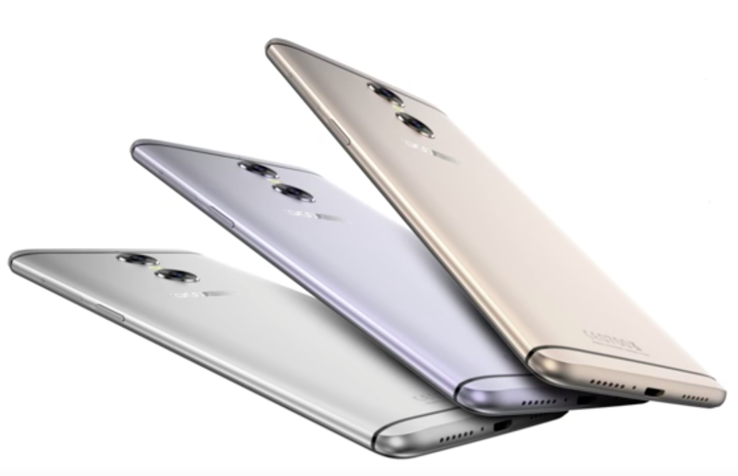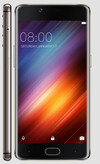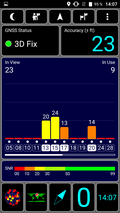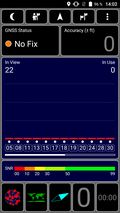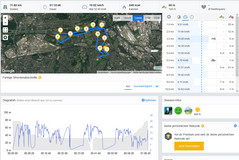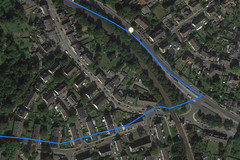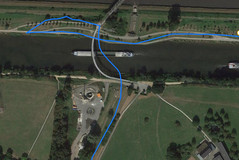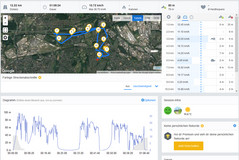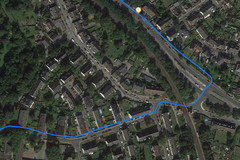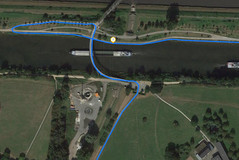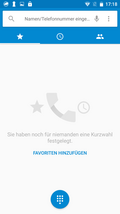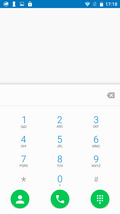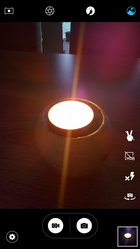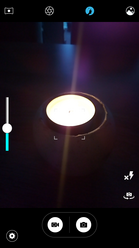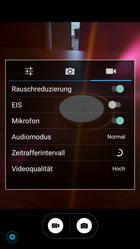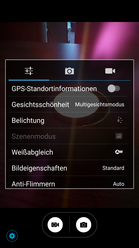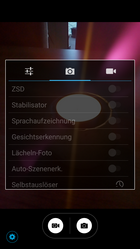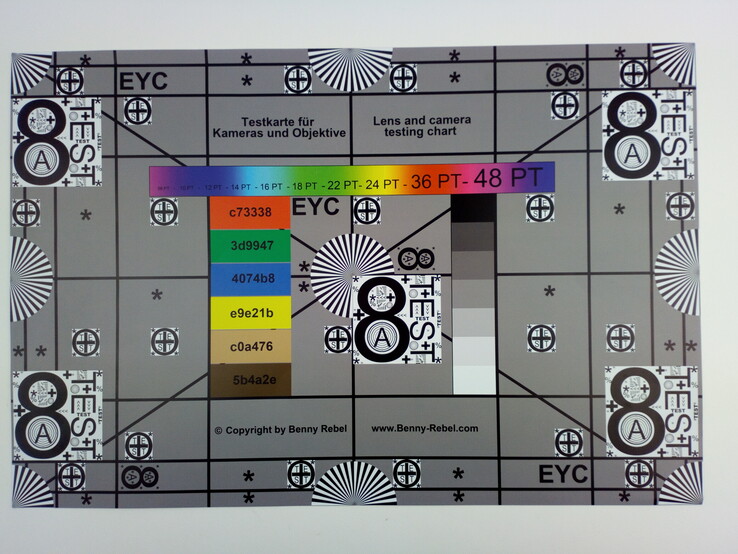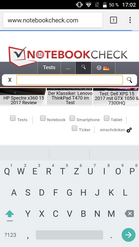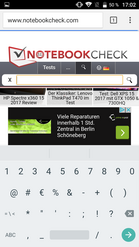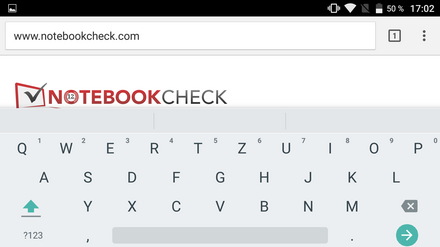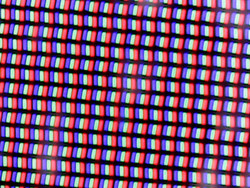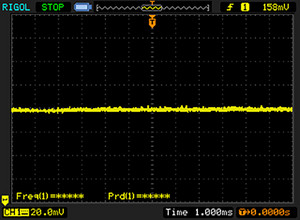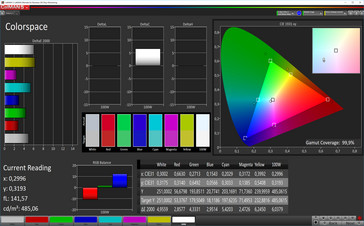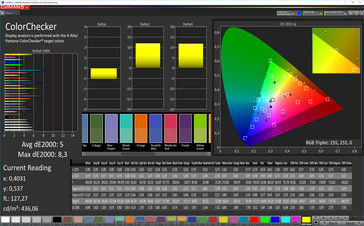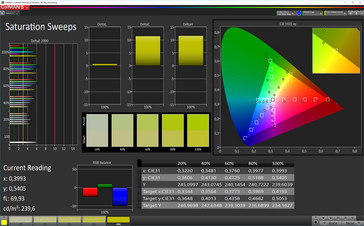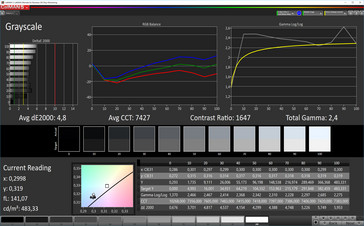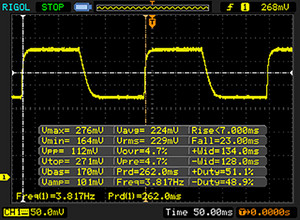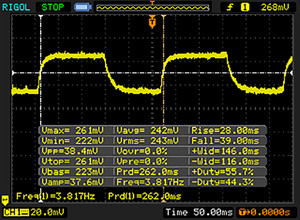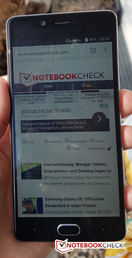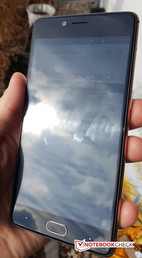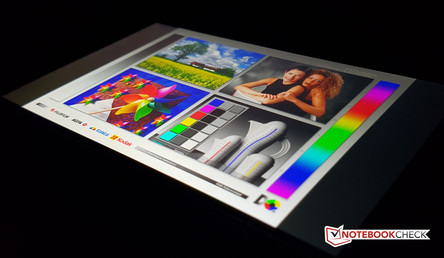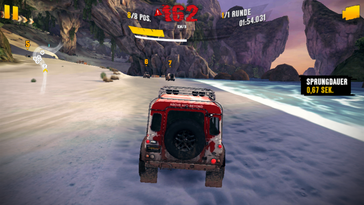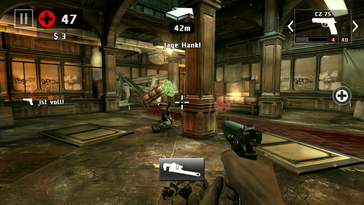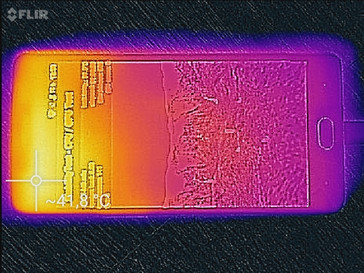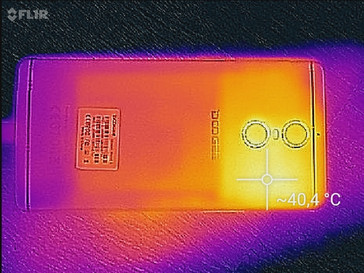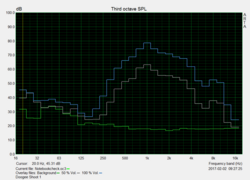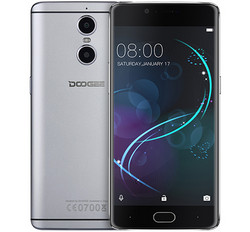Doogee Shoot 1 Smartphone Review
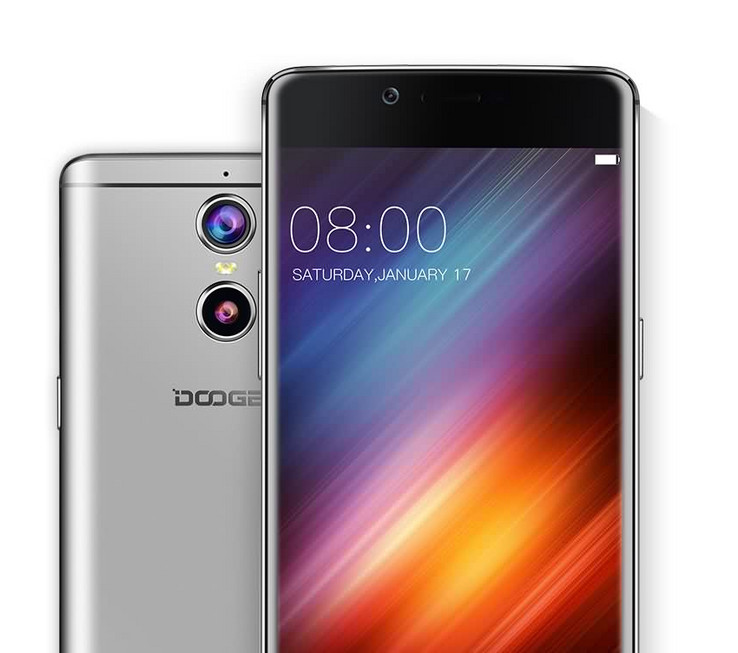
For the original German review, see here.
The Shoot series is a fresh sheet in the portfolio of the Chinese smartphone manufacturer Doogee, with a dual-camera system as the star feature. This innovation follows in the footsteps of the HTC One M8. The second camera module on the back of the device collects depth information that enables the phone to generate photos with the so-called bokeh effect. In the Doogee Shoot 1, the two back cameras have resolutions of 13 MP and 8 MP. The latter gathers information for the variable depth of focus.
The entry-level device costs around 110 Euros (~$120) and offers a few more technological features worthy of mention: a 5.5-inch Full HD IPS display, a MediaTek quad-core processor, and 2 GB of RAM. The 16 GB of internal storage can be expanded with a microSD card. With this price tag, the Shoot 1 is venturing into one of the most competitive rings a smartphone can enter. True, none of its rivals have a dual-camera system at their command, but the list of competitors is long. In this review we have chosen to compare our test device with the following models: the Wiko Lenny 3, the Archos 50 Platinum 4G, the Lenovo Moto G4 Play, the TP-Link Neffos C5, the Ulefone Metal, and two ZTE models: the Blade V7 Lite and the Blade A510. The LG X Cam does have two back cameras, but it comes at a street price of about 200 Euros (~$215).
Case
The Shoot 1's case, which is mostly plastic, is available in "galaxy gray", "obsidian black" and "mocha gold". Measuring 157 x 77 millimeters (~6 x 3 inches), the phone falls more into the phablet category; compact is not really a term anyone would use to describe the Shoot 1. The display takes up 69% of the overall surface area on the front of the device - an average ratio for a smartphone. At a thickness of almost 9 millimeters (~0.35 inches) and weight of 167 grams (~0.37 lbs), the Doogee device feels a little bulky. Furthermore, the plastic case does not give the impression of being particularly high-quality.
The quality of the volume control button and on/off switch is perfectly satisfactory; they hardly wiggle at all. Both buttons are made of plastic and have a well-defined click point. The home button on the front of the device is also firmly set in the case and lacks space to wobble. Overall, the smartphone's stability and manufacturing quality made a good impression in our tests.
Connectivity
The internal eMMC storage amounts to 16 GB and can be expanded with a microSD card to up to 256 GB. After subtracting the space occupied by the operating system, about 10.4 GB of (ROM) storage remains available to the user. In addition, once a microSD card is inserted, the user has the option to format the card and adopt it as internal storage. This enables the user to store compatible apps on the microSD card (App2SD).
The Shoot 1's home button is equipped with a fingerprint sensor that serves to unlock the smartphone. The LTE smartphone charges via the micro USB 2.0 port on the bottom of the device. Peripheral devices like USB sticks or external keyboards can be connected with an OTG (On the Go) adapter.
Software
In terms of system software, the Chinese manufacturer uses the Google Android version 6.0 Marshmallow operating system. At the time of our tests, the Shoot 1 had the security patch level of January 2017. Doogee has not indicated whether or not the phone will receive an update to Android 7.0 Nougat. Visually, the proprietary user interface is reminiscent of Google's Standard Android: compared to the Vanilla UI, it appears that Doogee has made only a few adjustments.
Communication and GPS
To connect to the internet on the go, the Shoot 1 uses LTE Cat. 4 (150 Mbit/s downstream, 50 Mbit/s upstream) in the frequencies 800, 900, 1800, 2100 and 2600 MHz. This includes support for LTE band 20, which is especially important in the rural regions of Germany. The dual-SIM smartphone has two micro-SIM card slots. Unlike many other smartphones, the mobile internet connection over the hybrid slot is not limited to GSM speed - both slots have access to LTE frequencies.
The integrated WLAN module supports the IEEE 802.11 standards a/b/g/n and transmits on both the 2.4 GHz and 5 GHz bands. In the immediate vicinity of the router (Telekom Speedport W921V), we measured a signal attenuation of -44 dBm. The Wi-Fi transfer speeds between the smartphone and our reference router (Linksys EA 8500) were very good for a device in this price range: at 101 Mbit/s (iperf server) and 107 Mbit/s (iperf client), the Doogee Shoot 1's speeds are above average for its class.
| Networking | |
| iperf3 transmit AX12 | |
| Huawei P9 | |
| Doogee Shoot 1 | |
| ZTE Blade A510 | |
| iperf3 receive AX12 | |
| Huawei P9 | |
| Doogee Shoot 1 | |
| ZTE Blade A510 | |
| iperf Server (receive) TCP 1 m | |
| Huawei P9 | |
| Ulefone Metal | |
| Archos 50 Platinum 4G | |
| Lenovo Moto G4 Play | |
| TP-Link Neffos C5 | |
| Wiko Lenny 3 | |
| LG X Cam | |
| iperf Client (transmit) TCP 1 m | |
| Huawei P9 | |
| Ulefone Metal | |
| LG X Cam | |
| TP-Link Neffos C5 | |
| Wiko Lenny 3 | |
| Archos 50 Platinum 4G | |
| Lenovo Moto G4 Play | |
The Shoot 1 determines its position via the GPS satellite system. Localization outdoors only occurs after long delays - if at all. In our test, the smartphone often failed to receive any satellite signal. When the device successfully localized itself, it was only accurate to about 6 or 7 meters (~20 or 23 yards). Indoors, the phone simply cannot receive satellite signals. The Shoot 1's GPS reception strength and location accuracy are below average, even for a low-budget device. As a result, the smartphone is not suitable for use as a navigational tool. On our ~12 kilometer-long test route (~7.5 miles), the GPS module in our entry-level smartphone reported the distance covered as 400 meters (0.25 miles) less than the distance recorded by our Garmin Edge 500 expert navigation device.
Telephone and Voice Quality
Cameras
The 13 megapixel main camera on the back of the device has a phase detection autofocus and a single-tone dual-LED flash. The Samsung image sensor (S5K3L8) has pixels with an edge length of 1.127 micrometers - for comparison, current high-end devices have pixels with an edge length of 1.55 micrometer. The larger the pixel area, the higher the light sensitivity of the exposure.
In good lighting conditions the camera quality is satisfactory, but the photos often lack sharpness and detail. Pictures taken in direct sunlight end up with bright areas that are clearly overexposed. In addition, the dynamic range in the photos is somewhat limited, which means that the shots darken visibly in strongly contrasted lighting. But even with the image noise and noticeable lack of sharpness, considering its price level, photos taken by the Shoot 1 are astonishingly bright and rich with detail. The dual-camera mode did not turn out quite as well. The fuzzy bokeh effect is often executed very iaccurately and ends up overlapping with the actual focus of the shot. Unfortunately, the depth of focus cannot be changed after the photo has been taken.
With a resolution of 8 megapixels, the front camera (Hynix Hi843) offers a satisfactory level of detail and quality for selfies - though the images often have a visible red cast.
The Doogee Shoot 1 records video at a maximum resolution of 1080p at 30 frames per second. If a video is shot with the 8 MP front camera, the video resolution is reduced to 720p at 30 FPS.
Accessories and Warranty
The Shoot 1 comes packaged with a modular power supply rated at 10 watts (5 volts, 2 amps), a USB cable, headphones, a protective film applied in the factory, and a transparent silicon case.
Doogee is selling their smartphone with a 12-month warranty. Read this article to learn what to look out for when buying from importers.
Please see our Guarantees, Return Policies and Warranties FAQ too for country-specific information.
Input Devices and Operation
The multi-touch screen (5 fingers) reacts accurately to input, and fingers glide comfortably across its scratch-resistant glass surface. The fingerprint reader on the front of the smartphone functions reliably, allowing the user to unlock the device via biometric identification. However, the speed of the active fingerprint sensor is not on par with that of current high-end smartphones (much less flagship models).
For on-screen text input, the manufacturer has installed the standard Google keyboard.
Display
The Shoot 1's 5.5-inch IPS LC display measures just under 14 centimeters (~5.5 inches) along the diagonal and is produced by the Japanese manufacturer Sharp. With a resolution of 1920x1080 pixels, the pixel density comes to 401 PPI. With a density like this, pixel structures are hardly recognizable at a normal distance. Even when the font is small, text content is sufficiently sharp.
The LED backlight glows at up to 488 cd/m² in the center of the display and has a black value of 0.23 cd/m². On average, however, the backlight is only strong enough to reach a brightness of 462 cd/m². The brightness distribution is only 89% across the screen, leaving certain portions of the display darker than others. The realistic APL50 test (Average Picture Level) with evenly distributed bright and dark regions measures a max brightness of only 400 cd/m² at a black value of 0.22 cd/m². Together, these numbers yield a very good contrast ratio of 1:1818.
| |||||||||||||||||||||||||
Brightness Distribution: 89 %
Center on Battery: 488 cd/m²
Contrast: 2122:1 (Black: 0.23 cd/m²)
ΔE ColorChecker Calman: 5 | ∀{0.5-29.43 Ø4.78}
ΔE Greyscale Calman: 4.8 | ∀{0.09-98 Ø5}
Gamma: 2.4
CCT: 7427 K
| Doogee Shoot 1 IPS, 1920x1080, 5.5" | ZTE Blade A510 IPS, 1280x720, 5" | ZTE Blade V7 Lite IPS, 1280x720, 5" | Archos 50 Platinum 4G IPS, 1280x720, 5" | Ulefone Metal IPS, 1280x720, 5" | Wiko Lenny 3 IPS, 1280x720, 5" | TP-Link Neffos C5 IPS, 1280x720, 5" | Lenovo Moto G4 Play IPS, 1280x720, 5" | LG X Cam IPS, 1920x1080, 5.2" | Huawei P9 IPS-NEO, JDI, 1920x1080, 5.2" | |
|---|---|---|---|---|---|---|---|---|---|---|
| Screen | -29% | -38% | -47% | -55% | -40% | -42% | -29% | -30% | -3% | |
| Brightness middle (cd/m²) | 488 | 528 8% | 312 -36% | 344 -30% | 312 -36% | 374 -23% | 508 4% | 412 -16% | 362 -26% | 582 19% |
| Brightness (cd/m²) | 462 | 524 13% | 302 -35% | 349 -24% | 315 -32% | 343 -26% | 491 6% | 414 -10% | 348 -25% | 563 22% |
| Brightness Distribution (%) | 89 | 94 6% | 79 -11% | 89 0% | 87 -2% | 85 -4% | 89 0% | 94 6% | 94 6% | 91 2% |
| Black Level * (cd/m²) | 0.23 | 0.62 -170% | 0.15 35% | 0.65 -183% | 0.56 -143% | 0.47 -104% | 0.58 -152% | 0.42 -83% | 0.25 -9% | 0.38 -65% |
| Contrast (:1) | 2122 | 852 -60% | 2080 -2% | 529 -75% | 557 -74% | 796 -62% | 876 -59% | 981 -54% | 1448 -32% | 1532 -28% |
| Colorchecker dE 2000 * | 5 | 5.2 -4% | 8.2 -64% | 5.8 -16% | 6.8 -36% | 6 -20% | 7 -40% | 5.6 -12% | 6.8 -36% | 4.4 12% |
| Colorchecker dE 2000 max. * | 8.3 | 8.7 -5% | 16.5 -99% | 10.7 -29% | 14 -69% | 11.9 -43% | 14.1 -70% | 9.7 -17% | 11.9 -43% | 7.4 11% |
| Greyscale dE 2000 * | 4.8 | 5.7 -19% | 9.2 -92% | 5.7 -19% | 7.1 -48% | 6.7 -40% | 6.1 -27% | 6.9 -44% | 8.4 -75% | 4.8 -0% |
| Gamma | 2.4 92% | 1.99 111% | 2.29 96% | 2.1 105% | 2.77 79% | 2.19 100% | 2.15 102% | 2.4 92% | 2.22 99% | 2.2 100% |
| CCT | 7427 88% | 6631 98% | 9017 72% | 7792 83% | 7402 88% | 8073 81% | 8068 81% | 8422 77% | 8242 79% | 6175 105% |
| Color Space (Percent of AdobeRGB 1998) (%) | 77.78 | |||||||||
| Color Space (Percent of sRGB) (%) | 99.44 |
* ... smaller is better
Screen Flickering / PWM (Pulse-Width Modulation)
| Screen flickering / PWM not detected | |||
In comparison: 53 % of all tested devices do not use PWM to dim the display. If PWM was detected, an average of 8111 (minimum: 5 - maximum: 343500) Hz was measured. | |||
In everyday use, from a subjective point of view the quality of the IPS panel won us over: screen content is displayed with rich contrast, and colors look bold but not oversaturated. Objectively, the colorimeter (CalMAN software) measurements reveal the panel's color representation to be somewhat too cool (7427 K; ideal: 6500 K). Both the grayscale (4.8) as well as the primary and mixed colors show substantial DeltaE 2000 deviations compared to the sRGB reference colors (target <3). For a device in this price range, however, overall these results are very good.
Display Response Times
| ↔ Response Time Black to White | ||
|---|---|---|
| 30 ms ... rise ↗ and fall ↘ combined | ↗ 7 ms rise | |
| ↘ 23 ms fall | ||
| The screen shows slow response rates in our tests and will be unsatisfactory for gamers. In comparison, all tested devices range from 0.1 (minimum) to 240 (maximum) ms. » 79 % of all devices are better. This means that the measured response time is worse than the average of all tested devices (20.2 ms). | ||
| ↔ Response Time 50% Grey to 80% Grey | ||
| 67 ms ... rise ↗ and fall ↘ combined | ↗ 28 ms rise | |
| ↘ 39 ms fall | ||
| The screen shows slow response rates in our tests and will be unsatisfactory for gamers. In comparison, all tested devices range from 0.165 (minimum) to 636 (maximum) ms. » 98 % of all devices are better. This means that the measured response time is worse than the average of all tested devices (31.6 ms). | ||
As is generally true of IPS panels, the display's viewing angle stability is very good. Even at extremely obtuse or acute angles, colors are not inverted and the screen darkens only slightly. Thanks to the bright, high contrast liquid crystal display, the screen content is easily visible in the outdoors.
Performance
The Doogee Shoot 1 is equipped with an entry-level MediaTek SoC (system on a chip) from the year 2016. The MT6737T quad-core processor is produced using 28 nanometer process technology and is based on the 64-bit capable Cortex A53 architecture. The chip clocks at a maximum of 1.5 GHz. For comparison: The cores of the MT6737 (without a T) clock at a maximum of just 1.35 GHz. Both versions have a Mali-T720 (MP2) graphics unit at their command.
Subjectively, the system performance is very good. In everyday use the system runs smoothly with hardly any significant delays - apps even open and close quickly. The system freezes and/or stutters only when heavily multitasking. In the synthetic benchmarks the Shoot 1 is on par with the UleFone Metal, which leads the competition. The browser speed in the Chrome browser is excellent for a device in this price bracket. Even the UleFone Metal cannot keep up with the Doogee smartphone in the browser benchmarks.
The internal 16 GB storage device's performance in linear reading and writing is good for a smartphone in this price bracket. Compared to the competition, the access speeds for small 4K data blocks are also very good. On the other hand, the speeds associated with the integrated microSD card slot are only average. We measured the slot's speeds with our reference memory card, the Toshiba Exceria Pro M401 (max. read: 95 MB/s, write: 80 MB/s). At 29 MB/s (read) and 20 MB/s (write), the slot's performance is acceptable for an entry-level device.
| AnTuTu v6 - Total Score (sort by value) | |
| Doogee Shoot 1 | |
| ZTE Blade A510 | |
| ZTE Blade V7 Lite | |
| Archos 50 Platinum 4G | |
| Ulefone Metal | |
| Wiko Lenny 3 | |
| TP-Link Neffos C5 | |
| Lenovo Moto G4 Play | |
| LG X Cam | |
| Huawei P9 | |
| Geekbench 4.0 | |
| 64 Bit Single-Core Score (sort by value) | |
| Doogee Shoot 1 | |
| ZTE Blade A510 | |
| Archos 50 Platinum 4G | |
| Ulefone Metal | |
| Huawei P9 | |
| 64 Bit Multi-Core Score (sort by value) | |
| Doogee Shoot 1 | |
| ZTE Blade A510 | |
| Archos 50 Platinum 4G | |
| Ulefone Metal | |
| Huawei P9 | |
| GFXBench (DX / GLBenchmark) 2.7 | |
| T-Rex Onscreen (sort by value) | |
| Doogee Shoot 1 | |
| ZTE Blade A510 | |
| ZTE Blade V7 Lite | |
| Archos 50 Platinum 4G | |
| Ulefone Metal | |
| Wiko Lenny 3 | |
| TP-Link Neffos C5 | |
| Lenovo Moto G4 Play | |
| LG X Cam | |
| Huawei P9 | |
| 1920x1080 T-Rex Offscreen (sort by value) | |
| Doogee Shoot 1 | |
| ZTE Blade A510 | |
| ZTE Blade V7 Lite | |
| Archos 50 Platinum 4G | |
| Ulefone Metal | |
| Wiko Lenny 3 | |
| TP-Link Neffos C5 | |
| Lenovo Moto G4 Play | |
| LG X Cam | |
| Huawei P9 | |
| GFXBench 3.0 | |
| on screen Manhattan Onscreen OGL (sort by value) | |
| Doogee Shoot 1 | |
| ZTE Blade A510 | |
| ZTE Blade V7 Lite | |
| Archos 50 Platinum 4G | |
| Ulefone Metal | |
| Wiko Lenny 3 | |
| TP-Link Neffos C5 | |
| Lenovo Moto G4 Play | |
| LG X Cam | |
| Huawei P9 | |
| 1920x1080 1080p Manhattan Offscreen (sort by value) | |
| Doogee Shoot 1 | |
| ZTE Blade V7 Lite | |
| Archos 50 Platinum 4G | |
| Ulefone Metal | |
| Wiko Lenny 3 | |
| TP-Link Neffos C5 | |
| Lenovo Moto G4 Play | |
| LG X Cam | |
| Huawei P9 | |
| GFXBench 3.1 | |
| on screen Manhattan ES 3.1 Onscreen (sort by value) | |
| Doogee Shoot 1 | |
| ZTE Blade A510 | |
| ZTE Blade V7 Lite | |
| Archos 50 Platinum 4G | |
| Ulefone Metal | |
| Wiko Lenny 3 | |
| LG X Cam | |
| Huawei P9 | |
| 1920x1080 Manhattan ES 3.1 Offscreen (sort by value) | |
| Doogee Shoot 1 | |
| ZTE Blade A510 | |
| ZTE Blade V7 Lite | |
| Archos 50 Platinum 4G | |
| Ulefone Metal | |
| Wiko Lenny 3 | |
| LG X Cam | |
| Huawei P9 | |
| PCMark for Android - Work performance score (sort by value) | |
| Doogee Shoot 1 | |
| ZTE Blade A510 | |
| Archos 50 Platinum 4G | |
| Ulefone Metal | |
| Wiko Lenny 3 | |
| TP-Link Neffos C5 | |
| Lenovo Moto G4 Play | |
| LG X Cam | |
| Huawei P9 | |
| JetStream 1.1 - Total Score (sort by value) | |
| Doogee Shoot 1 | |
| ZTE Blade A510 | |
| ZTE Blade V7 Lite | |
| Archos 50 Platinum 4G | |
| Ulefone Metal | |
| Wiko Lenny 3 | |
| TP-Link Neffos C5 | |
| Lenovo Moto G4 Play | |
| LG X Cam | |
| Huawei P9 | |
| Octane V2 - Total Score (sort by value) | |
| Doogee Shoot 1 | |
| ZTE Blade A510 | |
| ZTE Blade V7 Lite | |
| Archos 50 Platinum 4G | |
| Ulefone Metal | |
| Wiko Lenny 3 | |
| TP-Link Neffos C5 | |
| Lenovo Moto G4 Play | |
| LG X Cam | |
| Huawei P9 | |
| Mozilla Kraken 1.1 - Total (sort by value) | |
| Doogee Shoot 1 | |
| ZTE Blade A510 | |
| ZTE Blade V7 Lite | |
| Archos 50 Platinum 4G | |
| Ulefone Metal | |
| Wiko Lenny 3 | |
| TP-Link Neffos C5 | |
| Lenovo Moto G4 Play | |
| LG X Cam | |
| Huawei P9 | |
* ... smaller is better
Games
The DirectX 11.1 capable Mali-T720 MP2 graphics unit offers enough GPU performance to smoothly render demanding games from the PlayStore - for instance “Dead Trigger 2” - even if the frame rate drops occasionally. The game “Asphalt 8” meanwhile cannot be rendered smoothly at a high detail setting; here the Mali-T720 MP2 only reached 24 FPS in our test.
Emissions
Temperature
The surface temperatures never reach a critical level, although the Shoot 1 does heat up to a maximum of 40.1°C (104.2°F) on the back after a prolonged period under full load. But the surface of the device never grows uncomfortably warm, and certainly not hot.
(±) The maximum temperature on the upper side is 43 °C / 109 F, compared to the average of 35.2 °C / 95 F, ranging from 21.9 to 247 °C for the class Smartphone.
(±) The bottom heats up to a maximum of 40.1 °C / 104 F, compared to the average of 34 °C / 93 F
(+) In idle usage, the average temperature for the upper side is 31.5 °C / 89 F, compared to the device average of 32.9 °C / 91 F.
Speaker
The mono speaker on the bottom of the Shoot 1 reached a maximum volume of 83 dB(A) in our test - sufficiently loud for a smartphone. However, even in comparison with other entry-level devices, the speaker's sound quality is mediocre and could be described as tinny and unclean. The sound is dominated by high tones and not very linear; as to be expected, bass tones are non-existent.
Doogee Shoot 1 audio analysis
(+) | speakers can play relatively loud (82.6 dB)
Bass 100 - 315 Hz
(-) | nearly no bass - on average 16.6% lower than median
(-) | bass is not linear (17.3% delta to prev. frequency)
Mids 400 - 2000 Hz
(-) | very high mids - on average 18% higher than median
(±) | linearity of mids is average (12.1% delta to prev. frequency)
Highs 2 - 16 kHz
(±) | higher highs - on average 6.9% higher than median
(±) | linearity of highs is average (11.9% delta to prev. frequency)
Overall 100 - 16.000 Hz
(-) | overall sound is not linear (43.3% difference to median)
Compared to same class
» 87% of all tested devices in this class were better, 0% similar, 13% worse
» The best had a delta of 11%, average was 35%, worst was 134%
Compared to all devices tested
» 95% of all tested devices were better, 0% similar, 4% worse
» The best had a delta of 4%, average was 24%, worst was 134%
ZTE Blade A510 audio analysis
(±) | speaker loudness is average but good (80.3 dB)
Bass 100 - 315 Hz
(-) | nearly no bass - on average 32.1% lower than median
(±) | linearity of bass is average (7.2% delta to prev. frequency)
Mids 400 - 2000 Hz
(-) | very high mids - on average 15.8% higher than median
(-) | mids are not linear (16.8% delta to prev. frequency)
Highs 2 - 16 kHz
(±) | higher highs - on average 7.7% higher than median
(±) | linearity of highs is average (10.5% delta to prev. frequency)
Overall 100 - 16.000 Hz
(-) | overall sound is not linear (45.1% difference to median)
Compared to same class
» 87% of all tested devices in this class were better, 0% similar, 13% worse
» The best had a delta of 11%, average was 35%, worst was 134%
Compared to all devices tested
» 96% of all tested devices were better, 0% similar, 4% worse
» The best had a delta of 4%, average was 24%, worst was 134%
Archos 50 Platinum 4G audio analysis
(±) | speaker loudness is average but good (81.2 dB)
Bass 100 - 315 Hz
(-) | nearly no bass - on average 39% lower than median
(±) | linearity of bass is average (8.5% delta to prev. frequency)
Mids 400 - 2000 Hz
(±) | reduced mids - on average 8.1% lower than median
(±) | linearity of mids is average (9.6% delta to prev. frequency)
Highs 2 - 16 kHz
(+) | balanced highs - only 2.3% away from median
(+) | highs are linear (3.4% delta to prev. frequency)
Overall 100 - 16.000 Hz
(-) | overall sound is not linear (30.6% difference to median)
Compared to same class
» 79% of all tested devices in this class were better, 4% similar, 17% worse
» The best had a delta of 11%, average was 35%, worst was 134%
Compared to all devices tested
» 89% of all tested devices were better, 3% similar, 9% worse
» The best had a delta of 4%, average was 24%, worst was 134%
Frequency diagram comparison (checkboxes above are selectable/deselectable!)
Energy Management
Power Consumption
Although the devices we are comparing with the Shoot 1 are fitted with substantially smaller 5-inch displays, our test device's energy consumption rates are generally lower - with the exception of the ZTE Blade V7 Lite. With a maximum of 4.4 watts under load, the Shoot 1's power usage lies within a good range for a 5.5-inch smartphone. The device reached this rate at full brightness, with the SoC under maximum load using the Stability Test app.
| Off / Standby | |
| Idle | |
| Load |
|
Key:
min: | |
| Doogee Shoot 1 3300 mAh | ZTE Blade A510 2200 mAh | ZTE Blade V7 Lite 2500 mAh | Archos 50 Platinum 4G 2200 mAh | Ulefone Metal 3050 mAh | Wiko Lenny 3 2000 mAh | TP-Link Neffos C5 2200 mAh | Lenovo Moto G4 Play 2800 mAh | LG X Cam 2500 mAh | |
|---|---|---|---|---|---|---|---|---|---|
| Power Consumption | -16% | 9% | -8% | -73% | -34% | -39% | 0% | -1% | |
| Idle Minimum * (Watt) | 0.73 | 0.61 16% | 0.63 14% | 0.59 19% | 1.41 -93% | 0.76 -4% | 0.72 1% | 0.68 7% | 0.64 12% |
| Idle Average * (Watt) | 1.48 | 1.75 -18% | 1.37 7% | 1.68 -14% | 2.46 -66% | 2.16 -46% | 1.87 -26% | 1.58 -7% | 1.38 7% |
| Idle Maximum * (Watt) | 1.58 | 1.83 -16% | 1.71 -8% | 1.79 -13% | 2.83 -79% | 2.35 -49% | 2 -27% | 1.61 -2% | 1.43 9% |
| Load Average * (Watt) | 3.11 | 4.49 -44% | 2.82 9% | 4.22 -36% | 5.15 -66% | 4.65 -50% | 5.99 -93% | 3.36 -8% | 3.99 -28% |
| Load Maximum * (Watt) | 4.37 | 5.14 -18% | 3.36 23% | 4.26 3% | 7.05 -61% | 5.35 -22% | 6.45 -48% | 3.91 11% | 4.49 -3% |
* ... smaller is better
Battery Life
Despite the Shoot 1's relatively low energy consumption, the 3300 mAh lithium ion polymer battery reached a run time of "only" 8 hours and 21 minutes in our battery test designed to simulate practical, everyday use (brightness: 150 cd/m²). Compared to other devices, this is a good run time - though not at the top of its class. The battery charges fully in just under 2 hours.
| Doogee Shoot 1 3300 mAh | ZTE Blade A510 2200 mAh | ZTE Blade V7 Lite 2500 mAh | Archos 50 Platinum 4G 2200 mAh | Ulefone Metal 3050 mAh | Wiko Lenny 3 2000 mAh | TP-Link Neffos C5 2200 mAh | Lenovo Moto G4 Play 2800 mAh | LG X Cam 2500 mAh | |
|---|---|---|---|---|---|---|---|---|---|
| Battery runtime | |||||||||
| WiFi v1.3 (h) | 8.4 | 6.9 -18% | 8.6 2% | 6.4 -24% | 6.7 -20% | 9.2 10% | 7.6 -10% | 10.5 25% | 7.6 -10% |
Pros
Cons
Verdict
In our tests, the Doogee Shoot 1 proved itself to be a good entry-level smartphone in the lowest price bracket. With 16 GB of ROM and 2 GB of RAM, the amount of internal storage is reasonable for its price. Together with the MediaTek SoC, by and large the hardware package provides enough performance power for the system to run smoothly. In addition, the Doogee Shoot 1 offers a high-contrast, high-resolution IPS panel - and a good battery life.
The entry-level smartphone's special feature, the dual-camera system on the back of the device, is unfortunately somewhat disappointing. The software does not use the extra depth information very well - the bokeh effect it produces is inaccurate and tends to blur parts of the subject of the photos. All in all, though, the quality of "normal" shots can certainly match the competition in this price range.
We were less fond of the poor quality speaker, the deficient GPS module, and the somewhat high temperatures under load. The case could also be a little more elegant, in our opinion.
The Doogee Shoot 1 is an interesting alternative on the low-end market - but the second back camera module is not well implemented.
Doogee Shoot 1
- 03/13/2017 v6 (old)
Marcus Herbrich




